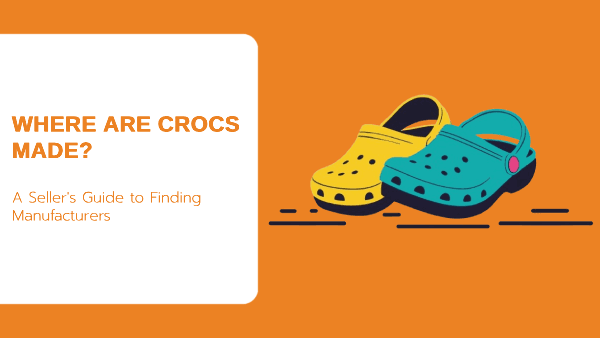Crocs have become a popular choice for footwear due to their comfort and unique design.
As a seller seeking to source products for your business, you might wonder: Where are Crocs products manufactured?
The straightforward answer is that Genuine Crocs are predominantly made in countries like China, Vietnam, Romania, Bosnia, Indonesia, and Mexico. Crocs also have plans to expand manufacturing to India.
If you’re in the business of selling shoes, dive into our guide on all things Crocs. We’ll show you how to source and sell quality footwear with ease and confidence.
Let’s get started.
The Origins of Crocs
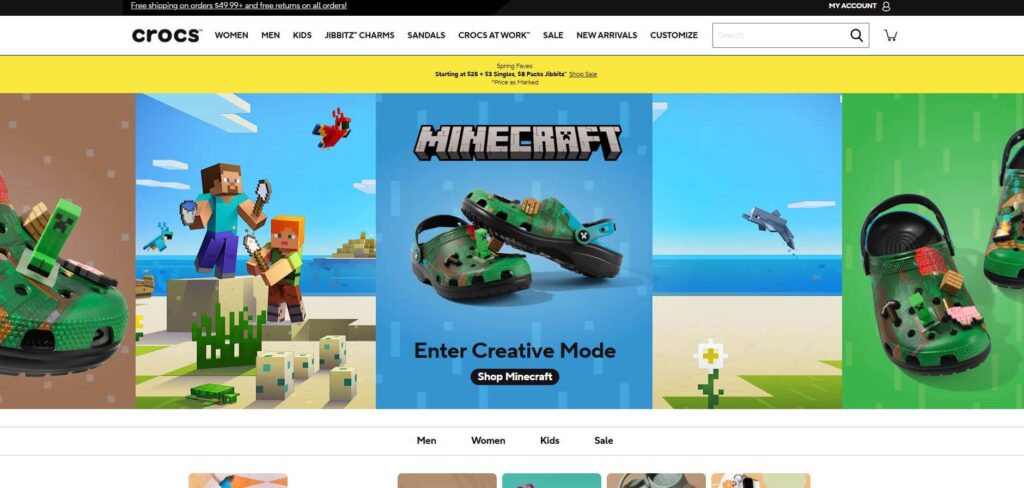
Crocs shoes were invented in 2002 by three friends, George B. Boedecker, Jr., Lyndon V. Hanson III, and Scott Seamans. They were inspired by a type of foam clog by Canadian brand Foam Creations, which they believed could make comfortable, durable footwear.
The company was founded in Niwot, Colorado, but its headquarters are now in Broomfield, Colorado. From the beginning, Crocs focused on using a special resin called Croslite, making the shoes lightweight and water-resistant.
The first Crocs shoes became popular due to their unique look and comfort. In 2004, Crocs became a public company by listing on the Nasdaq, which helped them raise funds to expand and grow.
By 2007, Crocs had sold over 50 million pairs of shoes. The brand continued to grow, and by 2024, Crocs had sold over 720 million pairs.
A key factor in Crocs’ success has been strategic marketing and collaborations with celebrities and brands like Justin Bieber, Post Malone, Balenciaga, and McDonald’s, turning what was once seen as a “functional” shoe into a fashion statement.
To meet global demand, Crocs has manufacturing facilities in countries like China, Vietnam, and Indonesia to meet global demand. Each pair is designed to be fun and functional, making them a favorite among people of all ages.
Where Are Crocs Made?
It’s worth noting that most Crocs are now made in factories not owned by the company. In recent years, Crocs started working with 26 third-party factories supplying products and materials.
A significant portion of these factories is concentrated in China and Vietnam. But the company also manufactures in Indonesia, India, Bosnia, Romania, Brazil, and Argentina.
Here’s a breakdown of where they are produced and why these places are significant.
Note: The Production Shares are estimates. They are not based on any official data released by Crocs.

1. Current Major Manufacturing Hubs
China
Production Share: Approximately 20-30%
China plays a significant role in Crocs’ manufacturing, supplying a large portion of the global inventory. Many factories in China specialize in producing EVA (ethylene-vinyl acetate) footwear, which is the core material used in Crocs’ signature Croslite™ foam.
Why China?
- Cost-Effective Production – Lower labor and material costs.
- Advanced Manufacturing Capabilities – Factories equipped for mass production.
- Strong Supply Chain – Easy access to raw materials and efficient logistics.
Vietnam
Production Share: Approximately 50%
Vietnam has become a top manufacturing hub for Crocs due to its lower labor costs compared to China and favorable trade agreements. The country also provides a stable alternative to mitigate risks from supply chain disruptions in China.
Why Vietnam?
- Skilled Workforce – Well-trained workers in footwear production.
- Trade Agreements – Export-friendly policies benefit global brands.
- High-Quality Production – Strict quality control measures.
Mexico
Production Share: Approximately 10%
Mexico is another key production center, especially for Crocs sold in North and South America. Manufacturing in Mexico allows for faster shipping times and lower import costs to the U.S.
Why Mexico?
- Proximity to the U.S. – Reduces logistics costs and delivery time.
- Growing Footwear Industry – Many global brands manufacture here.
India
Production Share: Approximately 10%
India has become an important manufacturing hub for Crocs, following the launch of its first production facility in Tamil Nadu in 2024.
This move helps the company reduce reliance on other countries like China and Vietnam while strengthening its presence in the Indian market.
Why India?
- New Manufacturing Facility – Crocs opened its Tamil Nadu factory in 2024, marking a major step in expanding local production.
- Growing Market – India’s demand for Crocs continues to rise, making local manufacturing a strategic choice.
- Cost-Effective Production – Lower labor and operational costs compared to Western markets.
Indonesia
Production Share: Approximately 5%
Indonesia is another key production location for Crocs. The country has a well-established footwear industry and offers competitive labor costs. Indonesian manufacturers produce Crocs for both local and international markets.
Why Indonesia?
- Growing Footwear Industry – Many brands outsource production here.
- Low Production Costs – Helps keep Crocs affordable for global markets.
Some Crocs products are made in Indonesia. This location helps diversify Crocs’ manufacturing base and reduce reliance on any single country.
2. European Manufacturing Locations
Bosnia and Herzegovina
Bosnia and Herzegovina are the new manufacturing sites for Crocs, with production facilities such as the one in Kotor Varoš.
Why Bosnia and Herzegovina?
- Skilled Workforce – The country has a longstanding tradition in the footwear industry, providing a pool of experienced workers.
- Competitive Production Costs – Lower labor and operational costs make it an attractive location for manufacturing.
- Strategic European Location – Proximity to key European markets facilitates efficient distribution and reduces shipping times.
Romania
Romania is another European location where Crocs are made. This helps the company serve the European market more efficiently.
Why Romania?
- Established Footwear Industry – Romania has a rich history in shoe manufacturing, offering expertise and quality craftsmanship.
- Cost-Effective Production – Competitive labor costs contribute to efficient manufacturing processes.
- European Union Membership – As an EU member, Romania provides favorable trade conditions and easier access to European markets.
3. South American Manufacturing Locations
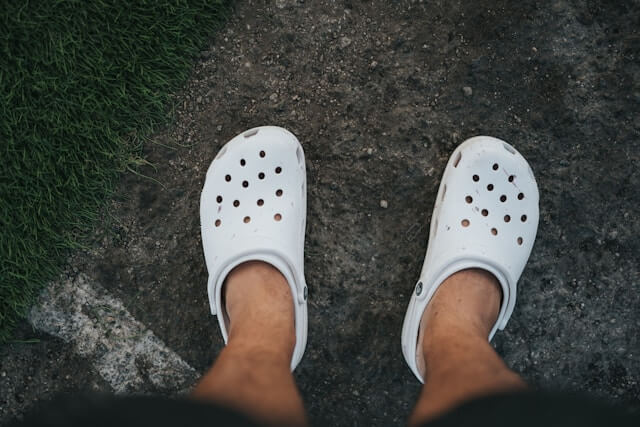
Brazil
In Brazil, Crocs operates through its subsidiary, Crocs Brasil Comércio de Calçados, based in Louveira, São Paulo.
This strategic location allows Crocs to effectively manage distribution and retail operations within the country.
Why Brazil?
- Established Subsidiary – The presence of Crocs Brasil Comércio de Calçados Ltda. facilitates direct oversight of operations and strengthens brand presence in the Brazilian market.
- Strategic Location – Operating from São Paulo, a major economic hub, enables efficient distribution across the country.
Argentina
In 2023, Crocs selected the Argentinian company Distrinando as one of its three global manufacturers, alongside facilities in Mexico and China. This partnership has led to significant growth, with Distrinando increasing its production by 83% between 2019 and 2023 and employing over 700 people.
Why Argentina?
- Strategic Manufacturing Location: Partnering with Distrinando allows Crocs to diversify its production and serve the South American market more effectively.
- Retail Expansion – Opening stores in prominent shopping centers such as the Patio Olmos shopping center in Córdoba increase the brands visibility,
4. Previous Manufacturing Locations
Canada
Crocs initially produced shoes in Canada. It’s unclear if they still manufacture there.
Italy
Crocs once operated a factory in Italy, known for quality and craftsmanship. However, according to CBS News, they recently closed this facility as part of restructuring efforts.
Are There Any OEM Crocs Factories in China?
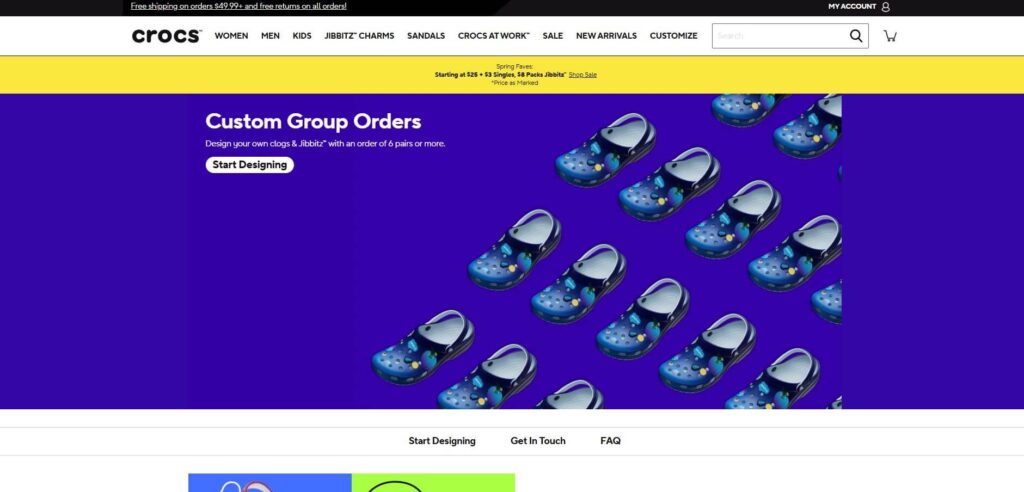
Yes, China remains a major hub for Croc manufacturers, including OEM (Original Equipment Manufacturer) factories that produce Crocs and similar footwear. While Crocs Inc. has expanded production to other countries, many Chinese companies specialize in manufacturing foam clogs through OEM services.
Key Croc Manufacturers in China
Several factories in China are involved in the production of Crocs or Crocs-like footwear:
- Crocs Industrial (Shenzhen) Co., Ltd. – While not explicitly an OEM factory for third-party brands, this facility is involved in manufacturing Crocs products.
- Guangdong Panyu Chuangxin Shoes – Known for producing Crocs-style footwear through OEM services.
- Guangdong Shenzhen Zengyu Shoes – A manufacturer based in Shenzhen, specializing in similar clog-style footwear.
- Hunan Kaisheng Shoes – An OEM factory in Hunan that manufactures Crocs-like footwear.
Additionally, many suppliers on platforms like Alibaba and Global Sources offer OEM, ODM (Original Design Manufacturer), and OBM (Own Branding & Manufacturing) services for footwear, including foam clogs.
Notable OEM Croc Manufacturers in China
- Fujian Waltz International Trading Co. Ltd – Specializes in OEM production of men’s and women’s clogs, with a strong export presence.
- Fujian Singyee I & E Co. Ltd / Fujian Chengda Shoes Co. Ltd – Manufactures foam clogs for international markets.
- Polywell Supply Management Co., Ltd – Primarily produces casual slippers but also offers OEM manufacturing services.
Why Does Crocs Use OEM Factories in China?
- Cost-Effective Production – Manufacturing in China helps Crocs and third-party sellers keep costs competitive.
- Established Supply Chain – Chinese factories have efficient access to raw materials and production facilities.
- Large-Scale Production – Many Chinese manufacturers can handle high-volume orders to meet global demand.
If you’re looking for Croc manufacturers in China, platforms like Alibaba list numerous suppliers offering OEM services. However, businesses should verify supplier credibility tomake sure they receive high-quality products.
How Are Crocs Footwear Made?
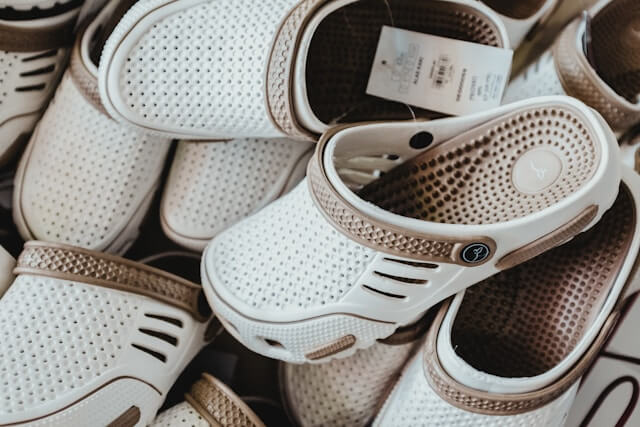
Crocs aren’t just another pair of casual shoes, they’re engineered for comfort and durability using a unique closed-cell resin material called Croslite™. But what actually goes into making them? Let’s break it down.
Step 1: The Secret Behind Croslite™
Unlike traditional rubber or plastic, Croslite™ is a proprietary EVA-based foam that gives Crocs their lightweight and cushioned feel. The material starts as tiny resin pellets, which are melted down and expanded into a moldable form.
This foam-like texture is what makes Crocs so soft and supportive, adapting to the shape of the wearer’s foot over time. It’s also non-toxic, odor-resistant, and waterproof, making it ideal for both casual wear and professional use.
Step 2: Molding the Perfect Croc
The real magic happens in the Crocs making machine, a high-tech injection molding system. Here’s how it works:
- Molten Croslite™ is injected into pre-designed molds at high pressure.
- The material expands, filling every corner of the mold to take on its signature clog shape.
- The shoes are then rapidly cooled to solidify their structure.
Unlike traditional footwear, Crocs don’t require stitching or gluing—the entire shape is formed in a single piece, making them incredibly durable and resistant to wear and tear.
Step 3: Finishing Touches
After molding, each pair undergoes a detailed finishing process:
- Straps and ventilation holes are carefully added, depending on the model.
- Some designs include fuzzy linings, embellishments, or even glow-in-the-dark features.
- The iconic Crocs logo is stamped on, ensuring brand authenticity.
Before hitting the shelves, every pair is checked for quality control—ensuring they meet Crocs’ high standards for comfort and durability.
Step 4: Packaging & Sustainability Efforts
Once approved, the shoes are cleaned, polished, and packed for shipping. But that’s not all—Crocs has also made strides toward sustainable production.
- The brand has introduced bio-based Croslite™, a more eco-friendly version of its foam material.
- It aims for net-zero carbon emissions by 2030, reducing its environmental footprint.
- Customers are encouraged to recycle worn-out Crocs through upcycling programs or donations.
If you want to start your own footwear line, you can learn a lot from Crocs and other popular footwear brands. Here’s a reading list to help you get started.
Read More
- Where Are Salomon Shoes Made
- Where Are Adidas Made
- Where Are Keen Shoes Made
- Where Are Asics Made
- Where Are Puma Shoes Made
- Where are Nike Shoes Made
- Where are Hoka Shoes Made
Key Factors to Consider When Choosing a Manufacturer

Location
Crocs are made in China, Mexico, Romania, etc. Each location may offer unique benefits. Choose a manufacturer in a country known for quality production. For instance, Crocs made in China represent around 40%-50% of their total production.
Cost
Manufacturing costs vary by country. For instance, countries like China, Indonesia, and Vietnam might offer lower labor costs. Consider total expenses, including shipping and import duties.
Quality Control
Ensure the manufacturer follows strict quality control protocols. High-quality standards ensure customer satisfaction and fewer product returns.
Production Capacity
Check the manufacturer’s ability to handle your order volume. If you plan to scale up, choose a manufacturer that can grow with you.
Lead Time
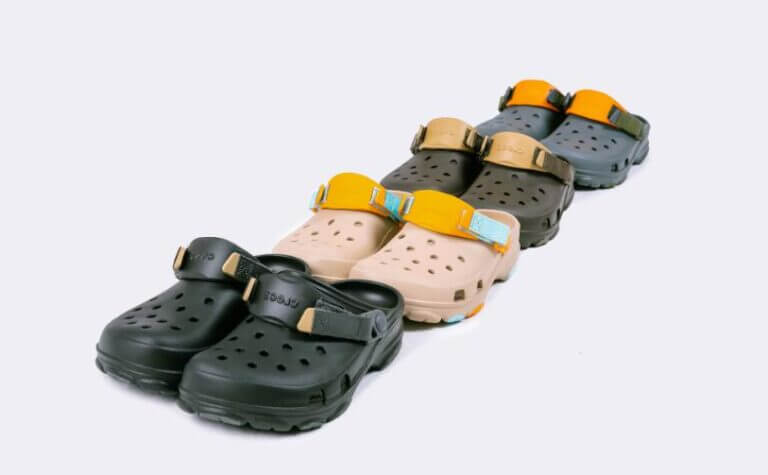
Understand the production timelines. How quickly can the manufacturer turn around an order? Fast lead times can be crucial during peak sales seasons.
Communication
Good communication is key. Make sure you can easily converse with the manufacturer and that they are responsive to your needs.
Certifications
Verify if the manufacturer has necessary certifications and follows ethical practices. Certifications like ISO 9001 for quality management can be important.
Reputation
Research the manufacturer’s reputation. Look for reviews or testimonials from other businesses that have worked with them.
Choosing the right manufacturer requires careful consideration of these factors to ensure a reliable, quality, and efficient partnership. For more detailed advice, check out our blog on how to get a product manufactured.
Frequently Asked Questions
When Were Crocs Invented?
Crocs were invented in 2002 by George B. Boedecker Jr., Lyndon V. Hanson III, and Scott Seamans. They were inspired by a foam clog from the Canadian company Foam Creations and later branded the material as Croslite™.
The first Crocs shoe, the Beach, debuted at the 2002 Fort Lauderdale Boat Show. It quickly gained popularity, leading to millions of sales within a few years. Today, Crocs have sold over 720 million pairs worldwide.
What Are the Different Types of Crocs Footwear?
Crocs offer a variety of footwear styles including clogs, sandals, flip-flops, loafers, and boots. Each type comes in multiple colors and patterns. The classic clog is the most popular, known for its comfort and unique design.
How to Recognize Fake Crocs?
Fake Crocs often lack the quality and details of genuine ones. Real Crocs have a distinctive logo on the strap button, proper labeling, and superior material. Checking these features can help you avoid counterfeit products. For more detailed advice, check out Croc’s official guidelines.
How Can Sellers Find Crocs Manufacturers for Business Partnerships?
To find the right Crocs manufacturers, you can explore leading suppliers in various countries. For instance, you can look at shoe manufacturers in China, where many high-quality footwear suppliers are based. Engaging with reputable suppliers ensures you get authentic products for your business.
Finding a Manufacturer with Niche
Crocs have gone from simple boating shoes to a global trend, thanks to their unique Croslite™ material and smart manufacturing strategy.
With factories across different countries, they keep up with demand while maintaining quality.
If you’re looking to start or grow your footwear business, having the right manufacturer makes all the difference. That’s where NicheSources can help.
We connect you with trusted footwear manufacturers for OEM production, private labeling, and bulk sourcing – all at great prices.
Get in touch with us today and take your footwear brand to the next level!
